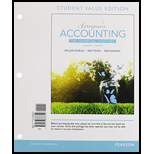
Concept explainers
Introduction:
Payback Period: Payback period is the period in which the project recovers its initial cost of the investment. It can be calculated by dividing the initial investment by the annual
Hence, smaller the payback period better it is. A project with the smaller payback period is chosen first in the capital rationing process.
NPV:
A project should be accepted if it has a positive NPV. Hence, higher the NPV better it is. A project with the Higher NPV is chosen first in the capital rationing process.
IRR:
A project should be accepted if it has an IRR greater than the required rate of return. Hence, higher the IRR better it is. A project with the Higher IRR is chosen first in the capital rationing process.
Profitability Index: Profitability Index is similar to the NPV method to evaluate a project. It calculates the ratio between the present value cash inflow and present value of
A project should be accepted if it has a PI more than or equal to 1. Hence, higher the NPV better it is. A project with the Higher NPV is chosen first in the capital rationing process.
To determine: The acceptable projects and their ranking
Want to see the full answer?
Check out a sample textbook solution
Chapter 26 Solutions
Horngren's Accounting, The Financial Chapters, Student Value Edition Plus MyLab Accounting with Pearson eText -- Access Card Package (11th Edition)
- PLEASE HELP WITH THIS PROBLEMarrow_forwardThe KLM Medical Clinic has two auxiliary departments: the Building Maintenance Department and the Energy Production Department as well as three main production departments: the Department of Paediatrics, the Department of Internal Medicine and the Department of Surgery. The CLM allocates the cost of the building maintenance department based on the area occupied by the departments in square meters and the cost of the energy department based on the days of hospitalization of patients. No distinction is made between variable and fixed cost elements. The budgeted operating figures for the previous year were as follows: Auxiliary sections Main production departments Building maintenance Energy production Pediatrics Department of Internal Medicine Surgical Estimated cost before allocation 18.000,00 8.000,00 80.000,00 50.000,00 90.000,00 Area (in sq.m) 1.000,00 4.000,00 6.000,00 18.000,00 12.000,00 Patient Hospitalization…arrow_forwardwhat is financial accounting? explain its parts and all things.arrow_forward
- Manufacturing products. Parrow_forward4. ABG produces and sells a single product at the price of 20 euros. During its first year of operation (20X7), the company had no initial stocks. The production cost of a product unit is as follows: Variable production cost of 8 euros per unit. Fixed production cost 9,600 euros. Also, the company has fixed sales expenses of 5,400 euros. In the first year of operation, the company had budgeted that it would produce and sell 3,200 units of product. In fact, during the period production and sales amounted to 3,200 units of product. Requested: To calculate the operating result of the company for the first year of its operation using absorption and marginal costing. Calculate the operating result of the company for the first year of its operation using absorption and marginal costing, assuming that sales for the period amounted to 2,700 units and 500 units remained as final inventory. What is the value of the final inventory of stocks with both costing techniques in this case?arrow_forwardHello experts solve this qnarrow_forward
- Please help me draw a flowchart for the breakfast drive-through scenarios.arrow_forward2. __________-entry bookkeeping means that every transaction will affect two or more accounts.arrow_forwardThe two main methods of bookkeeping and accounting are 1) the cash method, and 2) the __________ method.arrow_forward

 AccountingAccountingISBN:9781337272094Author:WARREN, Carl S., Reeve, James M., Duchac, Jonathan E.Publisher:Cengage Learning,
AccountingAccountingISBN:9781337272094Author:WARREN, Carl S., Reeve, James M., Duchac, Jonathan E.Publisher:Cengage Learning, Accounting Information SystemsAccountingISBN:9781337619202Author:Hall, James A.Publisher:Cengage Learning,
Accounting Information SystemsAccountingISBN:9781337619202Author:Hall, James A.Publisher:Cengage Learning, Horngren's Cost Accounting: A Managerial Emphasis...AccountingISBN:9780134475585Author:Srikant M. Datar, Madhav V. RajanPublisher:PEARSON
Horngren's Cost Accounting: A Managerial Emphasis...AccountingISBN:9780134475585Author:Srikant M. Datar, Madhav V. RajanPublisher:PEARSON Intermediate AccountingAccountingISBN:9781259722660Author:J. David Spiceland, Mark W. Nelson, Wayne M ThomasPublisher:McGraw-Hill Education
Intermediate AccountingAccountingISBN:9781259722660Author:J. David Spiceland, Mark W. Nelson, Wayne M ThomasPublisher:McGraw-Hill Education Financial and Managerial AccountingAccountingISBN:9781259726705Author:John J Wild, Ken W. Shaw, Barbara Chiappetta Fundamental Accounting PrinciplesPublisher:McGraw-Hill Education
Financial and Managerial AccountingAccountingISBN:9781259726705Author:John J Wild, Ken W. Shaw, Barbara Chiappetta Fundamental Accounting PrinciplesPublisher:McGraw-Hill Education





